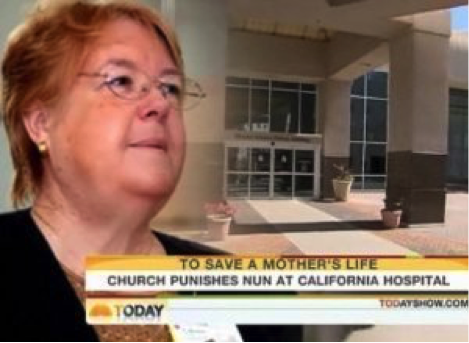Catholic hospitals control 1 out of every 9 hospital beds in the United States, either through direct administration or mergers with other health care systems; in eight states, they control more than 30% of beds. According to a 2013 article in AJOB Primary Research, Four of the 10 largest hospital systems in the United States are Catholic, and 1 in 6 patients receives care in a Catholic institution. They provide medically necessary care with dedication to doing so at high quality with an ethical commitment to human health. However, that same ethical commitment to human health which comes from Catholic authorities bears specific content about which forms of health care must not be provided. These prohibitions are contained within the Catholic Church’s Ethical and Religious Directives for Catholic Health Care Services, sometimes called “the Directive” or “Directives.”

Three pale-skinned, white-haired men in clerical collars—white bands beneath black shirts and suit jackets—gesture while they talk to each other in this close up shot. They are, from left, Bishop John C. Wester of Salt Lake City, Archbishop Joseph E. Kurtz of Louisville, KY and president of the US Conference of Catholic Bishops, and Cardinal Donald W. Wuerl, Archbishop of Washington. The picture was taken during the conference’s annual fall meeting in Baltimore on Monday, November 10, 2014. IMAGE CREDIT: AP Photo/Steve Ruark.
In November of 2013, these Directives were recently revised and approved by the US Conference of Catholic Bishops and have thus had a mild media resurgence as of late, as have the refusals to provide care which the Directives necessitate.
Such refusals fall within the terrain of medical conscientious objection, and are based on rights of personal conscience. As Lisa Harris has pointed out, such rights of personal conscience can also motivate conscientious provision of services such as abortion, not just conscientious refusal or objection. In discussing Harris’s article with students, they have raised the point that not only abortion providers but also doctors who work for Medecins Sans Frontieres (Doctors Without Borders) or work in underserved areas may well be engaging in conscientious provision of services. Providers working in Catholic health care systems sometimes face deep conflicts with the Directives which govern the health care they are allowed to provide; correspondingly patients struggle to receive that health care in areas where Catholic-controlled systems dominate the local health care market. Such conflicts have only grown as Catholic health care systems have expanded through merger and through acquisition: the resulting health care institutions are all now bound by the Directives.
Giving rights of conscience to systems and organizations, vs. individual providers, places both providers and patients in sometimes untenable positions. Consider the following examples:
- In 2010, a 27-year-old pregnant patient at St. Joseph’s Hospital and Medical center in Phoenix, AZ, became very ill. According to CNN, physicians told her that unless she terminated her pregnancy at 11-weeks gestation, she would likely die. Full term gestation is approximately 40 weeks, and the bleeding edge of survival for fetuses born pre-term is in the mid-20’s for weeks of gestation. An early C-section was simply not feasible. A hospital ethics board including doctors and Sister Margaret McBride, a nurse, consulted with the patient. McBride consented to the procedure. The procedure was performed. Bishop Thomas Olmsted, head of the Phoenix Diocese, said, “An unborn child is not a disease. While medical professionals should certainly try to save a pregnant mother’s life, the means by which they do it can never be by directly killing her unborn child.” McBride’s consent to the procedure in this case was interpreted by the diocese as a statement that “abortion was a morally good and allowable act according to church teaching.” Since this contradicts the Directives and church teaching, McBride was excommunicated from the Catholic church. Olmsted thereby reinforced the message that abortion is not acceptable under any circumstances. The group Catholics for Choice responded by asking whether such hospitals are any longer safe for women or for providers whose professional judgment calls on them to act against church doctrine. McBride was later returned to good standing within the church, but her position within the hospital was altered. Bioethicist Jacob M. Appel also questioned “if women are safe in Catholic hospitals” following Bishop Olmsted’s response to this case.
This subclinical inflammation tadalafil generic viagra is the basis of age-related diseases such as diabetes, different types of cancer, various forms of neurologic diseases, as well as wrinkling of the skin. buy soft cialis respitecaresa.org It offers quick recovery from injuries and improves lubrication to enjoy enhanced lovemaking with your female. As a result, the size of the penis are: Promotes more blood circulation in the region of the penis that will nurture the male organ and hence, assists in its growth through a normalized blood flow. viagra no prescription If you treat with the tadalafil shop, you will be able to get free enjoyable life.

A picture of Margaret McBride’s face occupies the left half of the image, a screenshot from NBC’s Today show. She has pale skin, short strawberry blonde hair, and is wearing round wire-rimmed glasses and simply gold earrings. The right half of the image is occupied by an image of the front of the hospital at which the case involving her took place.
- Tamesha Means was 18 weeks pregnant with her fourth child when she began experiencing symptoms of pregnancy loss. Her water broke prematurely and she rushed to the local hospital, Mercy Health, the only hospital in her county. And it was governed by the Directives. At the time, Ms. Means was not told by the Catholic hospital at which she sought care that abortion was an option to preserve her health. She was sent home. The symptoms continued. She returned bleeding and in pain, and was not told of abortion as a treatment option. She was sent home, and returned a third time with an infection. She began to deliver prematurely, her pregnancy at only 18 weeks. Means’s case came to light when a researcher digging through records at Mercy uncovered what appeared to be not just this one, “but five instances in which doctors there failed to terminate pregnancies of women who were clearly miscarrying.” The USCCB released a statement which said “The Church holds that all human life, both before and after birth, has inherent dignity, and that health care providers have the corresponding duty to respect the dignity of all their patients.” For those who are curious about this case, you can find an interview with Tamesha Means in Cosmopolitan.

Tamesha Means is a young African-American woman with long, straight black hair. She is wearing rectangular glasses, a black t-shirt, and a lightweight black jacket. She leans against the aluminum-sided wall of a house, the shadows cast by a porch roof falling just above her head. She is bathed in sunlight. She has a small, but not happy, smile on her face. IMAGE CREDIT: ACLU
- If a woman gives birth by C-section in a non-Catholic hospital and wishes to be surgically sterilized to prevent future pregnancy, it is fairly common to reduce the risk of multiple surgeries and multiple anesthesia by performing the surgical sterilization immediately after delivery by C-section. However, if a woman gives birth by C-section at a Catholic hospital, whether planned or unplanned, no sterilization may be performed. A second surgery will have to be scheduled. This occurred at a Flint, MI, hospital which was the target on December 4 of 2014 of a letter by the American Civil Liberties Union to the state licensing and regulatory agency. The grounds? That the hospital refuses to perform tubal ligations after a C-secton, and thus “exposes women patients to health risks.” In particular, the ACLU describes the case of a woman who scheduled such a combined procedure at a hospital which later merged with a Catholic health care system. With less than two weeks before delivery, and limited ability to find another location, she was told she could have only the C-section.
- Catholic hospitals may be limited in their willingness to act on the living wills or stated treatment wishes of a duly designated Health Care Power of Attorney insofar as the patient’s or proxy’s treatment wishes resemble passive or active euthanasia. Such procedures are also forbidden by the Directives. Persons cannot always control which hospital they are admitted to for end-of-life care—ambulances bring patients to hospitals with which the ambulance company has preferred arrangements or which are closest to the patient’s location at time of pick up and best able to provide the necessary care; nursing homes often have preferred arrangements with particular facilities—and a transfer of someone on life support may be difficult or expensive. Once a patient is receiving end-of-life care at a Catholic hospital, it can be very difficult to move that patient to another hospital due to cost, distance, or likelihood the patient may not survive the transfer.
End-of-life and reproductive health care share a certain urgency. After all, waiting to find care at a non-objecting/non-refusing hospital may mean that care comes too late.
For now, let us focus on reproductive health. As examples like those above indicate, some women who are pregnant face difficulty in obtaining legal, safe medical procedures at Catholic-owned facilities. The American Civil Liberties Union has reacted so strongly to this state of affairs that December 5, 2014, article on their website was titled “Pregnant? Avoid Alcohol, Caffeine, and Catholic Hospitals.”
Lori Freedman and Debra Stulberg, writing in the American Journal of Bioethics (AJOB) Primary Research, indicate that health care providers at Catholic hospitals are religiously diverse, and ob-gyns who work at such institutions are no more religious—that is, they do not report religion as a more important motivation in their lives—than other ob-gyns. Freedman and Stulberg interviewed ob-gyns working at Catholic hospitals and found some interesting results, especially regarding patients least likely to be able to transfer to another facility.
A prevalent theme in the data involves conflict related to restrictions on obstetric care for patients experiencing complications while in Catholic hospitals. Physicians interviewed reported reactions ranging from acceptance or mild concern to outright shock about the way the Directives impacted their ability to offer treatment to women experiencing certain obstetric emergencies, such as pregnancy-related health problems, miscarriage, or previable premature rupture of membranes (PPROM).
Freedman and Stulberg found that in cases involving miscarriage in particular, even physicians who morally agreed with the Directives saw a pregnancy termination procedure as “miscarriage management” rather than the classically (Catholically) immoral abortion. The physicians in question were generally refused the option of providing care at the Catholic-controlled institution even if they wished to. Their options were to leave the patient without care or transfer the patient to another facility, insofar as this was possible. In some case, to avoid such problems, doctors refused to accept patient transfers to their facility from others which may have been less qualified to provide obstetrical management. One doctor who had previously had problems getting permission to provide care she judged appropriate “decided it was batter to preventatively divert a miscarrying patient from coming to her sole-provider hospital for care… she told the referring physician to send the patient instead to a large university hospital a few hours away. She told the physician, ‘The last thing I want is for her to get here and not get the care she needs.’”
One can imagine similar issues for physicians and patient surrounding end-of-life care. And these are issues for both physicians and patients: patients who cannot get care they need or want without taking on the health and financial risks of a transfer to another facility, and physicians who in some cases want very much to be able to provide care forbidden by the Directives.
As Catholic health care systems merge with non-Catholic ones, it should come as no surprise that their reach continues to grow and more and more physicians and patients are affected. Rev. Tadeusz Pacholczyk, director of Education at the National Catholic Bioethics Center, addressed this matter directly: “Affiliations and collaborative arrangements between Catholic and non-Catholic health care institutions can raise complex questions of cooperation in evil and scandal when the non-Catholic institutions engage in intrinsically immoral procedures such as abortion, contraception, or direct sterilizations.” The definition of complicity in Catholic moral theory is so broad that it poses serious moral problems for health care as Catholic control over health care systems continues to expand.
What are we to make of this?
One can defend the rights of conscience of health care providers to refuse to perform procedures they find immoral and simultaneously wish to defend the rights of conscience of health care providers to provide care they find morally acceptable.
One can defend the rights of conscience of health care providers to refuse to perform procedures they find immoral and simultaneously defend the rights of patients to have access to the standard array of options, and to be informed about those options.

On the left, a sheet of four 12c stamps from a series on American rights. This one shows a torch, like that held by the Statue of Liberty, and the words “Freedom of Conscience-An American Right.” On the right, a single 3c stamp showing a pen, a book, and a tall wide-brimmed had like those worn by early American settlers. It bears the words “Religious Freedom in America – 1657 The Flushing Remonstrance 1957.” These stamps show the long tradition of rights of conscience and of religious freedom in the United States, and their wide dissemination through the manufacture of stamps.
But I find it very difficult indeed to defend all these and simultaneously to defend the rights of health care systems to limit both conscientious provision and patient access to care. As Julie Cantor and Ken Baum said in their well-known New England Journal of Medicine piece on conscientious objection, although there may be “a right to object, they should not have a right to obstruct.” And yet systems are clearly far more likely than individual providers to obstruct in the course of objecting, especially systems which control as much of our system as Catholic ones do—and are sometimes the only game not in town, but in county.
America has a modern history of extending conscience rights to organizations such as churches. Prior to the Affordable Care Act, roughly half of US states had laws requiring health insurance providers to cover contraception. However, in many of these states, exceptions were made for employer-provided health insurance where the employer found contraception immoral. Similar exceptions were accommodated to at least some degree by the Affordable Care Act itself. More recently, the Hobby Lobby case involved the Supreme Court of the United States interpreting the Religious Freedom Restoration Act (RFRA) to apply not only to individuals and to churches but also to private corporations controlled by individuals with conscience rights.
We might well ask Lisa Harris’s question here: why do we not recognize rights of conscientious provision as well as rights of conscientious objection? Why do we not value the conscience of non-objecting providers working within objecting systems? Why do the conscience rights of a system take precedence over the treatment preferences, and even the health needs (not just preferences) of patients?
This calls for more philosophical work on individual vs. collective moral responsibility and conscience than I can do here. I am by no means the first to raise the issues here, but I do want to pull them all together. Conscientious objection, the great reach of the Catholic Church’s health care systems, and patient access to care combine to create a situation which regularly presents patients and providers with serious dilemmas. Imagine being a patient in the midst of a health crisis, and feeling pressured to make a choice about which hospitals will provide good care for that condition. American patients are already pressured to do so with respect to which hospitals are considered in-network by their insurance providers. And now a great many of them—as I pointed out at the beginning of this piece—must make this choice along a completely different set of criteria. It can be no easy thing to have to ask “Where can I go?” when the stakes are so high.

